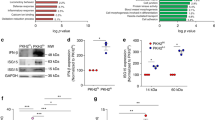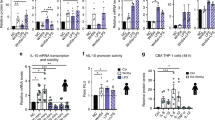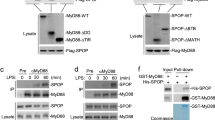Abstract
Dying cells stimulate inflammation, and this response is thought to contribute to the pathogenesis of many diseases. Very little has been known, however, about how cell death triggers inflammation. We found here that the acute neutrophilic inflammatory response to cell injury requires the signaling protein myeloid differentiation primary response gene 88 (Myd88). Analysis of the contribution of Myd88-dependent receptors to this response revealed only a minor reduction in mice doubly deficient in Toll-like receptor 2 (Tlr2) and Tlr4 and normal responses in mice lacking Tlr1, Tlr3, Tlr6, Tlr7, Tlr9, Tlr11 or the interleukin-18 receptor (IL-18R). However, mice lacking IL-1R showed a markedly reduced neutrophilic inflammatory response to dead cells and tissue injury in vivo as well as greatly decreased collateral damage from inflammation. This inflammatory response required IL-1α, and IL-1R function was required on non–bone-marrow-derived cells. Notably, the acute monocyte response to cell death, which is thought to be important for tissue repair, was much less dependent on the IL-1R–Myd88 pathway. Also, this pathway was not required for the neutrophil response to a microbial stimulus. These findings suggest that inhibiting the IL-1R–Myd88 pathway in vivo could block the damage from acute inflammation that occurs in response to sterile cell death, and do so in a way that might not compromise tissue repair or host defense against pathogens.
This is a preview of subscription content, access via your institution
Access options
Subscribe to this journal
Receive 12 print issues and online access
$209.00 per year
only $17.42 per issue
Buy this article
- Purchase on Springer Link
- Instant access to full article PDF
Prices may be subject to local taxes which are calculated during checkout




Similar content being viewed by others
References
Majno, G., La Gattuta, M. & Thompson, T.E. Cellular death and necrosis: chemical, physical and morphologic changes in rat liver. Virchows Arch. Pathol. Anat. Physiol. Klin. Med. 333, 421–465 (1960).
Antman, E.M. & Braunwald, E. Acute myocardial infarction. in Heart Disease: A Textbook of Cardiovascular Medicine 6th edn. (eds. Braunwald, E., Zipes, D.P. & Libby, P.) 1114–1231 (W.B. Saunders, Philadelphia, 2001).
Sawa, Y. et al. Leukocyte depletion attenuates reperfusion injury in patients with left ventricular hypertrophy. Circulation 93, 1640–1646 (1996).
Sekido, N. et al. Prevention of lung reperfusion injury in rabbits by a monoclonal antibody against interleukin-8. Nature 365, 654–657 (1993).
Jaeschke, H. Mechanisms of liver injury. II. Mechanisms of neutrophil-induced liver cell injury during hepatic ischemia-reperfusion and other acute inflammatory conditions. Am. J. Physiol. Gastrointest. Liver Physiol. 290, G1083–G1088 (2006).
Leadbetter, E.A. et al. Chromatin-IgG complexes activate B cells by dual engagement of IgM and Toll-like receptors. Nature 416, 603–607 (2002).
Lau, C.M. et al. RNA-associated autoantigens activate B cells by combined B cell antigen receptor/Toll-like receptor 7 engagement. J. Exp. Med. 202, 1171–1177 (2005).
Park, J.S. et al. High mobility group box 1 protein interacts with multiple Toll-like receptors. Am. J. Physiol. Cell Physiol. 290, C917–C924 (2006).
Li, M. et al. An essential role of the NF-kappa B/Toll-like receptor pathway in induction of inflammatory and tissue-repair gene expression by necrotic cells. J. Immunol. 166, 7128–7135 (2001).
Tsan, M.F. & Gao, B. Endogenous ligands of Toll-like receptors. J. Leukoc. Biol. 76, 514–519 (2004).
Scaffidi, P., Misteli, T. & Bianchi, M.E. Release of chromatin protein HMGB1 by necrotic cells triggers inflammation. Nature 418, 191–195 (2002).
Yu, M. et al. HMGB1 signals through toll-like receptor (TLR) 4 and TLR2. Shock 26, 174–179 (2006).
Kuida, K. et al. Altered cytokine export and apoptosis in mice deficient in interleukin-1 beta converting enzyme. Science 267, 2000–2003 (1995).
Fisher, C.J., Jr . et al. Role of interleukin-1 and the therapeutic potential of interleukin-1 receptor antagonist in sepsis. Circ. Shock 44, 1–8 (1994).
Ji, H. et al. Critical roles for interleukin 1 and tumor necrosis factor alpha in antibody-induced arthritis. J. Exp. Med. 196, 77–85 (2002).
Palmer, G. et al. Mice transgenic for intracellular interleukin-1 receptor antagonist type 1 are protected from collagen-induced arthritis. Eur. J. Immunol. 33, 434–440 (2003).
Shito, M. et al. Interleukin 1 receptor blockade reduces tumor necrosis factor production, tissue injury, and mortality after hepatic ischemia-reperfusion in the rat. Transplantation 63, 143–148 (1997).
Touzani, O., Boutin, H., Chuquet, J. & Rothwell, N. Potential mechanisms of interleukin-1 involvement in cerebral ischaemia. J. Neuroimmunol. 100, 203–215 (1999).
Suzuki, K. et al. Overexpression of interleukin-1 receptor antagonist provides cardioprotection against ischemia-reperfusion injury associated with reduction in apoptosis. Circulation 104, I308–I313 (2001).
Jaeschke, H. Role of inflammation in the mechanism of acetaminophen-induced hepatotoxicity. Expert. Opin. Drug Metab. Toxicol. 1, 389–397 (2005).
Fisher, T.C. & Meiselmann, H.J. Polymorphonuclear leukocytes in ischemic vascular disease. Thromb. Res. 74 Suppl. 1, S21–S34 (1994).
Abraham, E. Neutrophils and acute lung injury. Crit. Care Med. 31, S195–S199 (2003).
Liu, Z.X., Han, D., Gunawan, B. & Kaplowitz, N. Neutrophil depletion protects against murine acetaminophen hepatotoxicity. Hepatology 43, 1220–1230 (2006).
Dovi, J.V., He, L.K. & DiPietro, L.A. Accelerated wound closure in neutrophil-depleted mice. J. Leukoc. Biol. 73, 448–455 (2003).
Ward, P.A. & Hunninghake, G.W. Lung inflammation and fibrosis. Am. J. Respir. Crit. Care Med. 157, S123–S129 (1998).
Wipke, B.T. & Allen, P.M. Essential role of neutrophils in the initiation and progression of a murine model of rheumatoid arthritis. J. Immunol. 167, 1601–1608 (2001).
Zingarelli, B., Szabo, C. & Salzman, A.L. Blockade of Poly(ADP-ribose) synthetase inhibits neutrophil recruitment, oxidant generation, and mucosal injury in murine colitis. Gastroenterology 116, 335–345 (1999).
Romson, J.L. et al. Reduction of the extent of ischemic myocardial injury by neutrophil depletion in the dog. Circulation 67, 1016–1023 (1983).
Chen, C.J. et al. MyD88-dependent IL-1 receptor signaling is essential for gouty inflammation stimulated by monosodium urate crystals. J. Clin. Invest. 116, 2262–2271 (2006).
Fitzmaurice, G.M., Laird, N.M. & Ware, J.H. Applied Longitudinal Analysis (John Wiley & Sons, Hoboken, New Jersey, USA, 2004).
Acknowledgements
The authors thank R. Schreiber (Washington University) for the generous gift of IL-1α, IL-1β, IL-1R and glutathione S-transferase (isotype control) antibodies, R. Flavell (Yale University) for the caspase 1–deficient mice, M. Bianchi (San Raffaele Scientific Institute) for Hmgb1+/+ and Hmgb1−/− fibroblast cells, and K. Dresser and T. Smith (University of Massachusetts Medical School) for help with histology and photomicrographs. H.K. was supported in part by funds from Kanae Foundation. C.J.C. was supported in part by National Science Council, Taiwan (NSC95-2313-B002-120). This work was supported by grants from the US National Institutes of Health to K.L.R., and core resources supported by the Diabetes Endocrinology Research Center grant DK32520 were also used.
Author information
Authors and Affiliations
Contributions
C.J.C. and H.K. performed the experiments and contributed to the writing of the manuscript. D.G. provided reagents and advice and contributed conceptually to the project. G.R. performed statistical analyses. S.A. provided mice. K.L.R. initiated and supervised the project and contributed to the writing of the manuscript.
Corresponding author
Ethics declarations
Competing interests
The authors declare no competing financial interests.
Supplementary information
Supplementary Fig. 1
Injured cell-induced inflammation in C57BL/6 and B6129 (PDF 61 kb)
Rights and permissions
About this article
Cite this article
Chen, CJ., Kono, H., Golenbock, D. et al. Identification of a key pathway required for the sterile inflammatory response triggered by dying cells. Nat Med 13, 851–856 (2007). https://doi.org/10.1038/nm1603
Received:
Accepted:
Published:
Issue Date:
DOI: https://doi.org/10.1038/nm1603
This article is cited by
-
Abelson Helper Integration Site 1 haplotypes and peripheral blood expression associates with lithium response and immunomodulation in bipolar patients
Psychopharmacology (2024)
-
A novel missense compound heterozygous variant in TLR1 gene is associated with susceptibility to rheumatoid arthritis — structural perspective and functional annotations
Clinical Rheumatology (2023)
-
Galectin-3, a damage-associated molecular pattern, in tears of patients with vernal keratoconjunctivitis
Japanese Journal of Ophthalmology (2023)
-
Inhibitor of nuclear factor kappa B kinase subunit epsilon regulates murine acetaminophen toxicity via RIPK1/JNK
Cell Biology and Toxicology (2023)
-
The immunological mechanisms and therapeutic potential in drug-induced liver injury: lessons learned from acetaminophen hepatotoxicity
Cell & Bioscience (2022)



